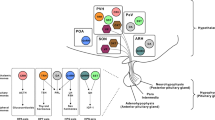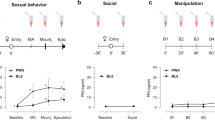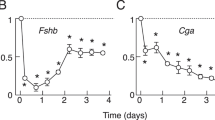Abstract
Prolactin-releasing peptide (PrRP) is a peptide ligand for the human orphan G-protein-coupled receptor hGR3/GPR10 and causes the secretion of prolactin from anterior pituitary cells1. However, the lack of immunoreactive staining for PrRP in the external layer of the median eminence seems to rule out this peptide as a classical hypophysiotropic hormone2,3,4 and, furthermore, PrRP is less effective than another inducer of prolactin secretion, thyrotropin-releasing hormone, both in vitro and in vivo5,6,7. Here we show a reduction in the expression of PrRP mRNA during lactation and fasting and an acute effect of PrRP on food intake and body weight, supporting the hypothesis of an alternative role for the peptide.
This is a preview of subscription content, access via your institution
Access options
Subscribe to this journal
Receive 12 print issues and online access
$209.00 per year
only $17.42 per issue
Buy this article
- Purchase on Springer Link
- Instant access to full article PDF
Prices may be subject to local taxes which are calculated during checkout


Similar content being viewed by others
References
Hinuma, S. et al. Nature 393, 272–276 (1998).
Iijima, N. et al. Neuroreport 10, 1713–1716 (1999).
Maruyama, M. et al. Endocrinology 140, 2326–2333 (1999).
Yamakawa, K., Kudo, K., Kanba, S. & Arita, J. Neurosci. Lett. 267, 113–116 (1999).
Matsumoto, H. et al. Biochem. Biophys. Res. Commun. 259, 321–324 (1999).
Samson, W. K., Resch, Z. T., Murphy, T. C. & Chang, J. K. Endocrine 9, 289–291 (1998).
Tokita, R. et al. Neurosci. Lett. 276, 103–106 (1999).
Roland, B. L. et al. Endocrinology 140, 5736–5745 (1999).
Ritter, R. C., Covasa, M. & Matson, C. A. Neuropeptides 33, 387–399 (1999).
Seeley, R. J. et al. J. Neurosci 20, 1616–1621 (2000).
Elmquist, J. K., Elias, C. F. & Saper, C. B. Neuron 22, 221–232 (1999).
Bhatnagar, S. & Dallman, M. F. Brain Res. 851, 66–75 (1999).
Brady, L. S., Smith, M. A., Gold, P. W. & Herkenham, M. Neuroendocrinology 52, 441–447 (1990).
Kristensen, P. et al. Nature 393, 72–76 (1998).
Acknowledgements
We acknowledge the support of the Biotechnology and Biosciences Research Council and AstraZeneca plc. We also thank N. Rothwell and A. Turnbull for commenting on the manuscript and A. Hardwick for technical assistance.
Author information
Authors and Affiliations
Corresponding author
Rights and permissions
About this article
Cite this article
Lawrence, C., Celsi, F., Brennand, J. et al. Alternative role for prolactin-releasing peptide in the regulation of food intake. Nat Neurosci 3, 645–646 (2000). https://doi.org/10.1038/76597
Received:
Accepted:
Issue Date:
DOI: https://doi.org/10.1038/76597
This article is cited by
-
A rare human variant that disrupts GPR10 signalling causes weight gain in mice
Nature Communications (2023)
-
An analogue of the Prolactin Releasing Peptide reduces obesity and promotes adult neurogenesis
EMBO Reports (2023)
-
Lipidated PrRP31 metabolites are long acting dual GPR10 and NPFF2 receptor agonists with potent body weight lowering effect
Scientific Reports (2022)
-
Hindbrain circuits in the control of eating behaviour and energy balance
Nature Metabolism (2022)
-
The Crosstalk Between Brain Mediators Regulating Food Intake Behavior in Birds: A Review
International Journal of Peptide Research and Therapeutics (2021)



